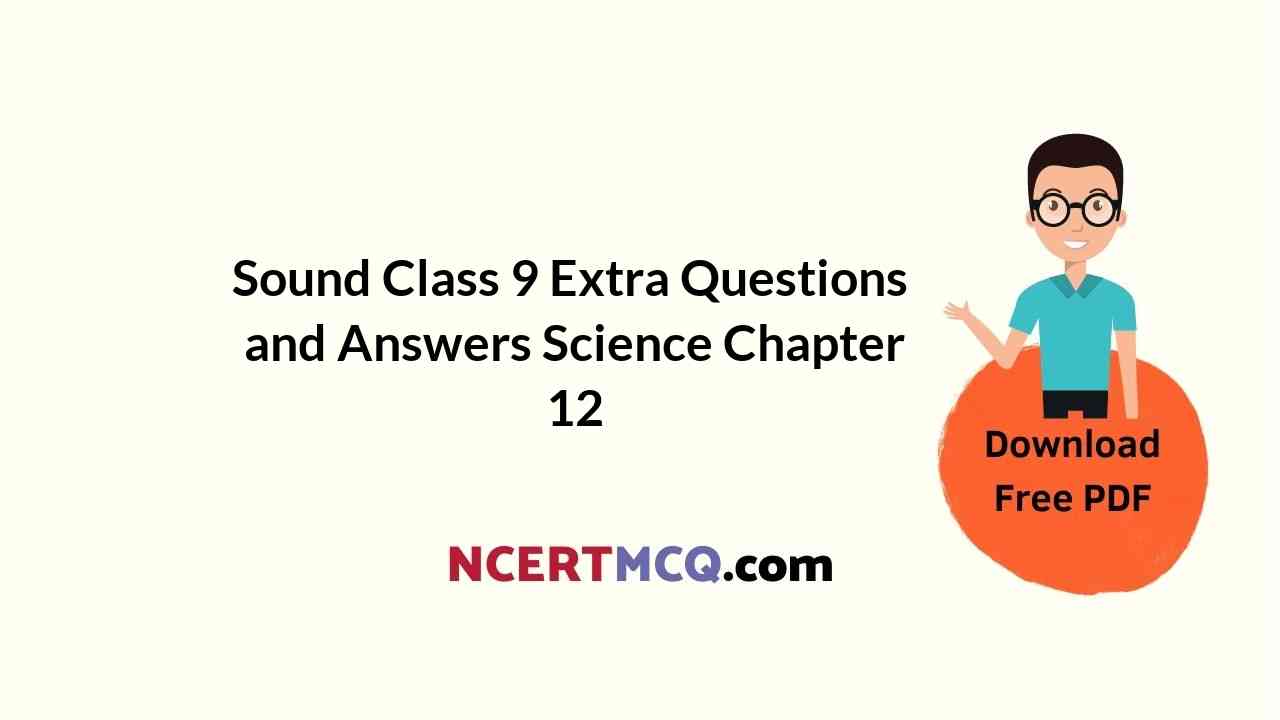In this page, we are providing Online Education for Sound Class 9 Extra Questions and Answers Science Chapter 12 pdf download. NCERT Extra Questions for Class 9 Science Chapter 12 Sound with Answers will help to score more marks in your CBSE Board Exams. https://ncertmcq.com/extra-questions-for-class-9-science/
Online Education for Class 9 Science Chapter 12 Extra Questions and Answers Sound
Extra Questions for Class 9 Science Chapter 12 Sound with Answers Solutions
Sound Class 9 Extra Questions Very Short Answer Type
Class 9 Science Chapter 12 Extra Questions And Answers Question 1.
What are longitudinal waves?
Answer:
A wave in which the particles of the medium vibrate back and forth in the ‘same direction’ in which the wave is moving, is called as a longitudinal wave.
Class 9 Science Chapter Sound Extra Question Answer Question 2.
What are transverse waves?
Answer:
A wave in which the particles of the medium, vibrate up and down ‘at right angle’ to the direction in which the wave is moving, is called a transverse wave.
Sound Class 9 Extra Questions Answers Question 3.
Define wavelength. What is its symbol and its SI unit?
Answer:
The distance between two consecutive compressions (C) or two consecutive rarefactions (R) is called the wavelength. The wavelength is denoted by (Greek letter ‘lambda’). Its SI unit is the metre (m).
Sound Class 9 Extra Questions Question 4.
Define frequency. What is its symbol and its SI unit?
Answer:
The number of complete waves (or cycles) produced per second is called a frequency of sound waves. It is denoted by f. The SI unit of frequency is hertz (Hz).
Sound Class 9 Worksheet With Answers Question 5.
What is one hertz?
Answer:
A vibrating body producing 1 wave per second is said to have a frequency of 1 Hz.
Sound Extra Questions And Answers Class 9 Question 6.
Define amplitude. What is its symbol and its SI unit?
Answer:
The magnitude of the maximum disturbance in the medium on either side of the mean value is called the amplitude of wave. It is denoted by A. The SI unit is the metre (m).
Sound Chapter Class 9 Extra Questions Question 7.
What is ‘audible’ sound?
Answer:
The sound which we are able to hear is called ‘audible’ sound. The audible range of sound for human beings extends from about 20 Hz to 20000 Hz.
Extra Questions On Sound Class 9 Question 8.
What do you mean by an echo?
Answer:
The repetition of sound caused by the reflection of sound waves is called an ‘echo’.
Numericals On Sound For Class 9 Question 9.
What do you understand by the terms “compression” and rarefaction?
Answer:
A region of high pressure of a medium when a sound wave travels through it is called compression.
A region of low pressure of a medium when a sound wave travels through it is called rarefaction.
Class 9 Science Sound Extra Questions Question 10.
What do you understand by the pitch of a sound?
Answer:
Pitch of a sound is the characteristic of sound that depends on the frequency received by a human ear.
Extra Questions Of Sound Class 9 Question 11.
What do you understand by the loudness of sound?
Answer:
The amplitude of the vibrating body determines the loudness of the sound. Larger the amplitude of vibration, larger the loudness of the sound produced.
Sound Chapter In Physics Class 9 Questions And Answers Question 12.
Define the characteristic “timbre” or “quality” of a sound.
Answer:
Quality or timbre is a characteristic of a sound which enables us to distinguish between two sounds of the same loudness and pitch.
Sound Class 9 Important Questions With Answers Question 13.
What is Sonar?
Answer:
Sonar is a device that uses ultrasonic wave to measure the distance, direction and speed of the underwater object.
Class 9 Sound Extra Questions Question 14.
What is Echocardiography?
Answer:
The technique of obtaining images of the heart by using the reflection of ultrasonic waves from various parts of the heart is called echocardiography.
Class 9 Science Chapter Sound Extra Question & Answer Question 15.
What is ultrasonography?
Answer:
The technique of obtaining images of internal organs of the body by using echoes of ultrasonic waves is called ultrasonography.
Question 16.
What is a stethoscope?
Answer:
The stethoscope is a medical instrument used for listening sounds produced within the body, chiefly in the heart or lungs.
Question 17.
What are infrasonic waves?
Answer:
The waves of frequency less than 20 Hz are called infrasonic waves.
Question 18.
What is ultrasound?
Answer:
The waves of frequency greater than 20,000 Hz are called ultrasonic waves or ultrasound.
Question 19.
Speed of sound is more on a hotter day. Explain why.
Answer:
Speed of sound increases with increase in temperature.
Question 20.
WrIte down the SI unit of (i) frequency (ii) wavelength.
Answer:
SI unit of wavelength is m and frequency is Hz.
Sound Class 9 Extra Questions Numericals
Question 1.
The sound produced by a thunderstorm is heard 10 s after the lightning is seen. Calculate the approximate distance of the thunder cloud. (Given the speed of sound = 340 ms’).
Ans. Given, t = 10 s
υ = 340 m/s
distance, x = υ x t = 340 x 10 = 3400 m.
Question 2.
What is the frequency of wave with time period 0.025 s?
Answer:
Given, t = 0.025 s
frequency, v = \(\frac{1}{t}=\frac{1}{0.025}\) = 40 Hz.
Sound Class 9 Extra Questions Short Answer Type 1
Question 1.
What is sound? When is the sound produced? Give examples.
Answer:
The sensation felt by our ears is called sound. A sound is a form of energy which makes us hear. When an object is set into vibrations, the sound is produced. For example, the vibrating diaphragm of a drum produces sound, the vibrating string of a guitar produces sound, the vibrating diaphragm of speakers of a radio produce sound, the vibrating end of a drilling machine produces sound, etc.
Question 2.
State the conditions to hear an echo.
Answer:
The conditions to hear an echo are:
1. Echo can be heard only if it is produced at least \(\frac {1}{10}\) th of a second (0.1 s) after the original sound.
2. The speed of sound in air is 344 m/s. Let us calculate the minimum distance from the reflecting surface, which is necessary to hear an echo.
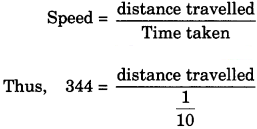
∴ Distance travelled = 344 x \(\frac {1}{10}\) = 34.4 metres
Thus, the distance travelled by the sound in \(\frac {1}{10}\) th of a second is 34.4 m. This means that the minimum distance between the source of the sound and the listeners should be 17.2 metres.
3. Echo can be heard only if the reflecting surface is large.
Question 3.
Bats search out prey and fly in the dark night by emitting ultrasound. Explain.
Answer:
Bats search out prey and fly in the dark night by emitting and detecting reflections of ultrasonic waves. The high-pitched ultrasonic squeaks of the bat are reflected from the obstacles or prey and returned to bat’s ear. The nature of reflections tells the bat where the obstacle or prey is and what it is like.
Question 4.
Mention one advantage and one disadvantage of reverberation.
Answer:
A certain amount of reverberation improves the quality of sound of orchestral and choral music. However excessive reverberation makes the speech or music indistinct.
Question 5.
How does a megaphone works?
Answer:
A megaphone works on the principle of reflection of sound. In this instrument, a tube followed by a conical opening reflects sound successively to guide most of the sound from the source in the forward direction towards the audience.
Sound Class 9 Extra Questions Numericals
Question 1.
If the velocity of sound in air is 340 ms-1. Calculate
1. wavelength when the frequency is 256 Hz.
2. frequency when the wavelength is 0.85 m.
Answer:
Given,
velocity of sound, υ = 340 m/s
1. v = 256 Hz
using, υ = λ v
λ = \(\frac {υ}{λ}\) = \(\frac {340}{256}\) = 1.33m
2. λ = 0.85
using, u = λv
λ = \(\frac {υ}{λ}\) = \(\frac {340}{0.85}\) = 400Hz
Question 2.
30 waves pass through a point in 3 seconds. If the distance between two crests is 2 m. Calculate
(a) frequency
(b) wavelength.
Answer:
30 waves in 3 seconds
υ = \(\frac {30}{3}\) = 10Hz
∴ λ = 2m.
Sound Class 9 Extra Questions Short Answer Type 2
Question 1.
What is the reflection of sound? State the laws of reflection.
Answer:
The bouncing back of sound from a hard surface is called a reflection of sound. The laws of reflection are:
1. The incident sound wave, the reflected sound wave and the normal at the point of incidence, all lie in the same plane.
2. The angle of incidence of sound is always equal to the angle of reflection of sound.
Question 2.
On what factor does the speed of sound depend?
Answer:
The speed of sound depends upon the following:
- The nature of the material (or medium) through which it travels. In general, sound travels fastest in solids, slower in liquids and slowest in gases.
- The humidity of the air. As the humidity of air increases, sound travels faster. Sound has more speed in humid air than in dry air.
- The temperature. The speed of sound in air at 0°C is 332 m/s whereas at 20°C, it is 344 m/s. Thus, as the temperature rises, the speed of sound also increases.
Question 3.
Write a note on ‘ultrasonic sounds’.
Answer:
- The sounds of frequencies higher than 20,000 Hz are known as ‘ultrasonic sounds’ (or just‘ultrasounds’).
- Human beings cannot hear ultrasonic sounds. Children under the age of five and some animals, such as dogs can hear sounds up to 25,000 Hz.
- As people grow older, their hearing sensation for higher frequencies becomes weaker.
- Ultrasonic sounds are used by dolphins, bats and porpoises to navigate in dark and to catch their prey.
- Some moths can hear high-frequency ultrasonic squeaks of the bat and know when a bat is flying nearby and are able to escape capture. Rats also play games by producing ultrasound.
Question 4.
Write three differences between transverse and longitudinal waves.
Answer:
Transverse waves:
- In the transverse waves, the particles of the medium vibrate perpendicular to the direction of wave motion.
- These waves travel in the form of alternate crest and trough.
- These waves can be transmitted through solid or liquid surfaces.
Longitudinal waves:
- In longitudinal waves, the particles of the medium vibrate along the direction of wave motion.
- These waves travel in the form of alternate compression and rarefactions.
- These waves can be transmitted through all the three types of media viz., solid, liquid and gases.
Question 5.
Write down three differences between a sound wave and lightwave.
Answer:
Sound wave:
- It travels in the form of longitudinal waves.
- It requires a medium for its propagation.
- It travels through air with a speed of 332 propagation. m/s at 0°C.
Lightwave:
- It travels in the form of a transverse wave.
- It does not require a medium for its propagation.
- It travels through air with a speed of nearly 3 x 108 m/s.
Sound Class 9 Extra Questions Long Answer Type
Question 1.
State three applications of reflection of sound.
Answer:
1. Megaphone and a bulb horn: Megaphones or loudhailers, horns, musical instruments such as trumpets and she Hana is, are all designed to send sound in a particular direction without spreading it in all directions, as shown in the figure. In these instruments, a tube followed by a conical opening reflects sound successively to guide most of the sound waves from the source in the forward direction towards the audience.

2. Stethoscope: Stethoscope is a medical instrument used for listening to sounds produced within the body, chiefly in the heart or lungs. In stethoscopes, the sound of the patient’s heartbeat reaches the doctor’s ears by multiple reflections of sound, as shown in the figure.
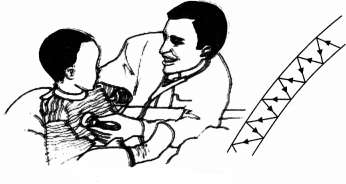
3. Soundboard: Generally the ceiling of concert halls, conference halls and cinema halls are curved so that sound after reflection reaches all corners of the hall, as shown in the figure. Sometimes a curved soundboard may be placed behind the stage so that the sound, after reflecting from the soundboard, spreads evenly across the width of the hail (Fig).
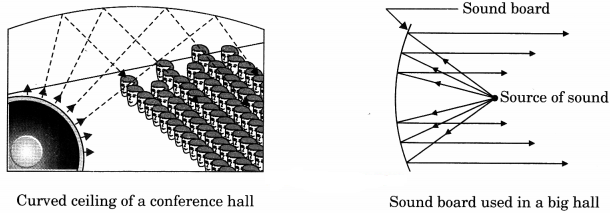
Question 2.
State the applications of ultrasound.
Answer:
Ultrasounds are high-frequency waves. Ultrasounds are able to travel along well-defined paths even in the presence of obstacles. Ultrasounds are used extensively in industries and for medical purposes.
1. Ultrasound is generally used to clean parts located in hard-to-reach places, for example, spiral tube, odd-shaped parts, electronic components, etc. Objects to be cleaned are placed in a cleaning solution and ultrasonic waves are sent into the solution. Due to high frequency, the particles of dust, grease and dirt get detached and drop out. The objects thus get thoroughly cleaned.
2. Ultrasounds can be used to detect cracks and flaws in metal blocks. Metallic components are generally used in the construction of big structures like buildings, bridges, machines and also scientific equipment. The cracks or holes inside the metal blocks, which are invisible from outside reduces the strength of the structure.
Ultrasonic waves are allowed to pass through the metal block and detectors are used to detect the transmitted waves. If there is even a small defect, the ultrasound gets reflected back indicating the presence of the flaw or defect.
3. Ultrasonic waves are made to reflect from various parts of the heart and form the image of the heart. This technique is called ‘echocardiography’.
4. An ultrasound scanner is an instrument which uses ultrasonic waves from getting images of internal organs of the human body. A doctor may image the patient’s organs such as liver, gall bladder, uterus, kidney, etc. It helps the doctor to detect abnormalities, such as stones in the gall bladder and kidney or tumours in different organs.
In this technique, the ultrasonic waves travel through the tissues of the body and get reflected from a region where there is a change of tissue density. These waves are then converted into electrical signals that are used to generate images of the
organ.
These images are then displayed on a monitor or printed on a film. This technique is called ‘ultrasonography’. Ulträsonography is also used for examination of the foetus during pregnancy to detect congenital defects and growth abnormalities.
5. Ultrasound may be employed to break small ‘stones’ formed in the kidneys into fine grains. These grains later get flushed out with urine.
Sound Class 9 Extra Questions HOTS
Question 1.
Why do we hear the sound produced by the humming bees while the sound of vibrations of a pendulum is not heard?
Answer:
This is because the frequency of the sound produced by humming bees lies in audible range and frequency of the sound of vibrations of pendulum lies in the infrasonic region.
Question 2.
Sounds of same loudness and pitch but produced by different musical instruments like a violin and flute are distinguishable.
Answer:
It is the quality of sound which enables us to distinguish between two sounds of the same loudness and pitch.
Question 3.
Which of the two graphs (a) and (b) shown in the figure below represents the human voice is likely to be the male voice? Give a reason for your answer. (NCERT Exemplar)
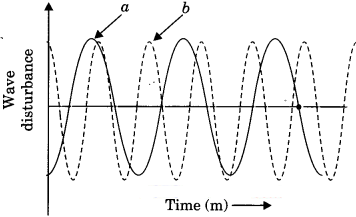
Answer:
Graph a represents the male voice because the frequency of male voice is less than that of the female voice.
Question 4.
The given graph (Fig.) shows the displacement versus time relation for a disturbance travelling with velocity 1500 ms-1. Calculate the wavelength of the disturbance. (NCERT Exemplar)

Answer:
Here, frequency, u = \(\frac {1}{T}\)
T = 2 ms = 2 x 10-6 s
Hence υ = \(\frac{1}{2 \times 10^{-6}}\) = 5 x 105 Hz
using relation, λ. = \(\frac{v}{v}=\frac{1500}{5 \times 10^{5}}\) = 3 x 10-2 m
Question 5.
For hearing the loudest ticking sound heard by the ear, find the angle x in the Figure. (NCERT Exemplar)
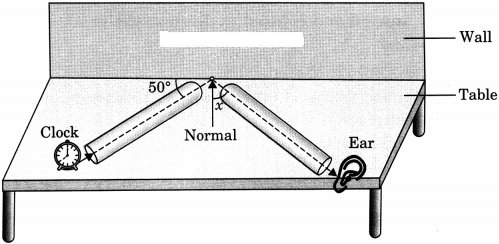
Answer:
Here angle of incidence,
i = 90° – 50° = 40°
Angle of incidence (i) or Angle of reflection (x)
x = i = 40°.
Sound Class 9 Extra Questions Value Based (VBQs)
Question 1.
Sumeet went to a hill station with his parents and elder sister Kirti. He was experiencing the scenic beauty of a hill station for the first time. One day they were walking in a forest area, Sumeet loudly called out ‘Kirti Didi’. He was surprised that he could distinctly hear the same sound twice. He discussed this with his sister and she explained the reason behind this echo.
Answer:
(a) The repetition of sound caused by the reflection of sound waves is called an echo.
(b) Kirti is intelligent and helpful.
Question 2.
Tinku studies in class 9th. Once he was suffering from cold and cough and was running a high temperature. His mother took him to a doctor. The doctor examined the chest and back of Tinku with the help of a device ‘stethoscope’. While examining with stethoscope doctor asked Tinku to take longer breaths. After examining Tinku, the doctor prescribed some drugs.
By regular use of these drugs, Tinku was normal within four days. But he could not understand the purpose of being examined by the use of a stethoscope. During winter break his cousin Honey, who was studying in a medical college, visited their place. On the request of Tinku, Honey explained the purpose of the stethoscope and its action.
(a) What is a stethoscope?
(b) What quality was shown by Honey?
Answer:
(a) The stethoscope is a medical instrument used for listening to sounds produced within the body, chiefly in the heart or lungs.
(b) Honey is intelligent and helpful.
Question 3.
On a hot summer afternoon, a man was shouting through a megaphone. He was ‘zip-repairer’. As Arshi was preparing for her examination, she got disturbed. She inquired her father about the instrument being used by the ‘zip-repairer’. The father told her that it was a megaphone also known as ‘loud hailer’.
(a) State the principle on which the megaphone works.
(b) Why did Arshi get disturbed?
Answer:
(a) Megaphone works on the principle of multiple reflections.
(b) Arshi got disturbed by noise pollution.
Question 4.
Reena’s grandmother took her mother to a doctor as she was four months pregnant for ultrasonography. But she showed her interest in determining whether the child is a boy or a girl. The doctor was annoyed and refused to disclose the gender of the child.
(a) What is ultrasonography?
(b) Write down the values shown by the doctor.
Answer:
(a) The technique of obtaining images of internal organs of the body by using echoes of ultrasound waves is called ultrasonography.
(b) A Doctor is a law-abiding person.
